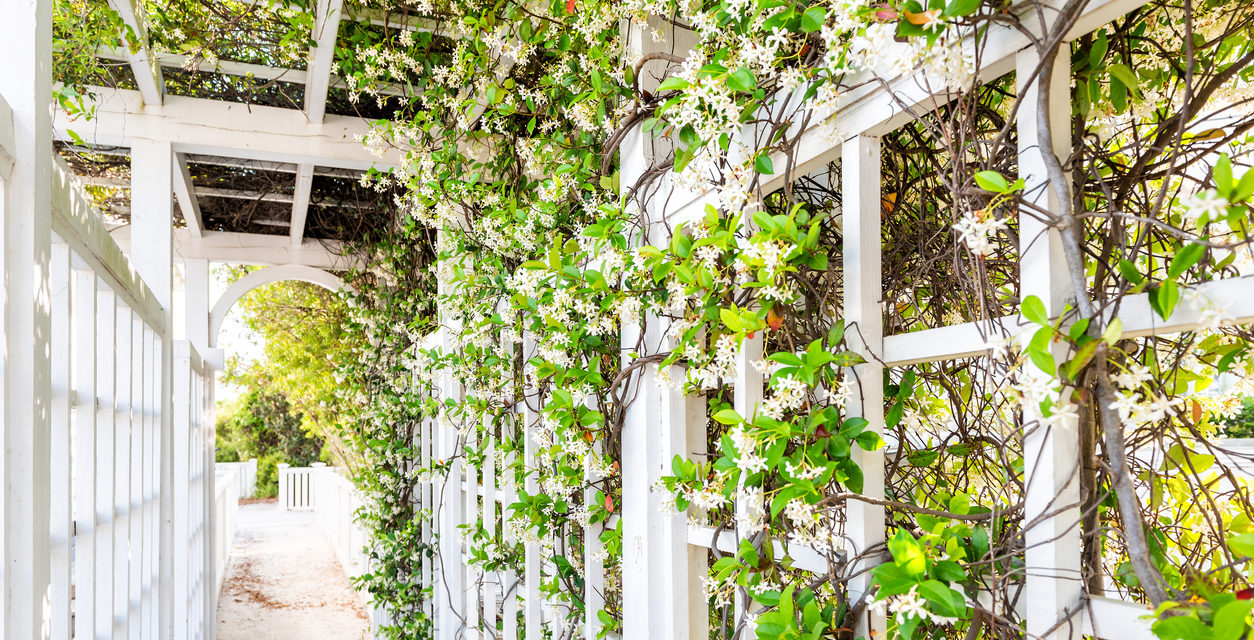Vines can add instant pizazz to your garden. Vertical interest, color, a welcoming shady space, flowers and foliage are only a few of the attributes they add. It can be a bit tricky to match a vine to the structure it will climb. Vines can climb four ways: twining, rambling, tendrils and clinging. Understanding how a vine climbs will help you match the vine to the structure.
Twining vines possess either stems or leaves that coil around their support in a spiral. They can be woody or herbaceous and annual or perennial. They require slender structures to begin climbing but by mid- summer might need sturdy support to hold the weight of the vine. These are good choices for metal or wood trellises or arbors. If the vines are perennial, such as honeysuckle and wisteria, make sure your structure will support them at maturity. Annual vines include morning glory, moonflower, scarlet runner bean and hyacinth bean.
Rambling vines, such as climbing roses, have no means of attachment. They climb only in the sense that their stems have thorns to hook themselves through adjacent shrubs or trees.
Stems of twining and rambling vines can be woven through any open support, such as a trellis or wire fence, once they are long enough.
Tendrils are slender, threadlike appendages of a climbing plant, often growing in a spiral. They stretch out and twine around any suitable support. They coil around small objects, often climbing up the stems of other plants. Sweet peas and grapes have small, twining tendrils at the bases of their leaves. The tendrils grab and wrap around anything they can reach.
Clematis climb by coiling leafstalks. These are not tendrils, but they behave very much like tendrils, coiling around anything they can. For these and tendril-producing vines, it is important to monitor their climbing early in the season. They can quickly become a tangled mess if not trained at the start. Supports for these plants should be fairly thin and spaced close together.
Some clinging vines have disclike pads that cling quite strongly to supportive structures such as the façade of a building. Boston ivy and Virginia creeper are examples. Plants also can cling using aerial roots. These vines, such as English ivy, use small, root-like structures that grow from the stem’s sides to support themselves. These rootlike structures attach readily to rough textured surfaces such as masonry, wood and bark.
These clingers are the vines that truly climb anything. Carefully plan where to plant them, as they can be invasive and damage the surfaces they climb.
Consider adding at least one vine to your garden this summer. Most annual vines can be started from seed once the danger of frost is past. You might be surprised how much you love these summertime stars.
When you have questions, Colorado State University Extension has research-based answers. The Help Desk opened April 15 at 17 N. Spruce St. Hours are 9 a.m. to noon and 1 to 4 p.m. Mondays and Wednesdays. Call 520-7684 or email CSUmg2@elpasoco.com.

 Photo Credit: krblokhin (iStock).
Photo Credit: krblokhin (iStock). 



Comment on: The Best Vines for Your Garden